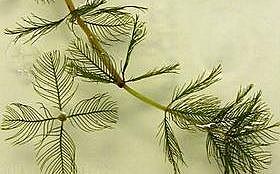About Milfoil
Eurasian Watermilfoil (Myriophyllum spicata) is an aquatic plant native to Europe, Asia, and North Africa. It was first identified in Vermont in the early 1960’s. Since then it has spread to many lakes and ponds in the state. As a nonnative species with no natural predators, it spreads easily and grows quickly. It is a submerged plant that grows in the littoral zone (edges of a waterbody where light can penetrate) of lakes and ponds and forms dense mats on the water surface. It has been found to grow in water as deep as 14 feet. These dense surface mats change the natural lake environment, out-competing and eliminating the more beneficial native aquatic plants, and severely reducing natural plant diversity within the lake and preventing fish and other aquatic fauna from spawning. In addition, it interferes with swimming, entangles boat propellers, and makes navigation through the infested areas nearly impossible.
Milfoil spreads when plant pieces break off, float on the water currents, and re-root elsewhere. For this reason, it is important to limit movement through dense stands, as the plants are brittle and easily break off, thus spreading throughout a waterbody. It can also spread by hitchhiking on boats or fishing gear moving from one water body to another, making constant vigilance necessary. The LIA Greeter Program and Boat Wash station was specifically set up to inspect boats entering Lake Iroquois to insure no other invasives come in and also to inspect boats leaving the lake to insure that no milfoil from this lake is carried to other lakes.

Appearance
Eurasian Watermilfoil is a rooted, submerged aquatic plant. The leaves are feathery and green while the stems appear brown to reddish. It produces small pinkish flower spikes. While it produces some seeds, it is most successful at propagating by rooting fragments. It grows to the surface of the water, forming dense mats.
Control Options
For many years, LIA has been researching control options to combat Eurasian Water Milfoil(EWM) which was first detected in Lake Iroquois in 1990 near the public boat ramp. According to the aquatic plant survey of the lake sponsored by the LIA and conducted by Northeast Aquatic Research in 2014, milfoil covers 70 acres of the lake whose total surface area is 247 acres. In 1984, 45 native aquatic plant species were documented in the lake but by 2014 only 33 native species could be found (a 27% decline). In the most recent plant survey of 2019, only 32 native species were found meaning a loss of yet another native species due to the milfoil infestation. EWM was the most common species found in the lake, occurring in 43% of the points surveyed. In addition to choking out native plant species, dense milfoil weed beds are poor spawning areas for fish thus reducing native fish populations. In the northern portions of the lake dense surface mats of milfoil are making fishing, boating and swimming virtually impossible.
Once an invasive like milfoil is established in a waterbody, it is nearly impossible to completely eradicate. However, it can be reduced and controlled to a level so that it will cease to interfere with recreational uses of the lake and it will allow a resurgence of native species and an improvement in the overall health and water quality of the lake. The fight against milfoil is a long-term project which requires investment of time and money for years to come. Not only do we need to reduce what is growing in the lake now but we also must continue to be vigilant in preventing invasives from being carried into the lake and to continue efforts to reduce the nutrients flowing into the lake that feed the milfoil.
There are only a few truly effective options for reducing and managing such a huge milfoil infestation. These include diver-assisted suction harvesting (DASH), bottom barriers, and the use of herbicides.
DASH
The LIA carried out DASH on Lake Iroquois in 2016 and 2018. After several weeks of work, the boat was able to clear the boat access channel only. By using DASH we found that, while effective for clearing small dense areas of milfoil, this method was too slow and much too expensive to clear the large infestation we are dealing with.
Bottom Barriers
The LIA also acquired bottom barriers to place in the boat channel in order to keep it clear after DASH was done. However, this method is not suitable for widespread areas of the lake as these barriers kill everything they are placed on – beneficial native plants as well as the invasive milfoil – as well as amphibians or other creatures living on the lake bottom.
Herbicide
Limited use of herbicide has been found to be the most effective method in other Vermont lakes. Though also expensive it is more affordable and effective than DASH and if used correctly and sparingly can be a useful part of a milfoil management plan. Although other herbicides have been used in the past, the state of Vermont is currently only approving one herbicide, ProcellaCOR, for use in controlling milfoil. Combining these methods along with prevention, education, and reduction of the nutrients that encourage milfoil growth are part of the LIA Integrated Management Plan.
